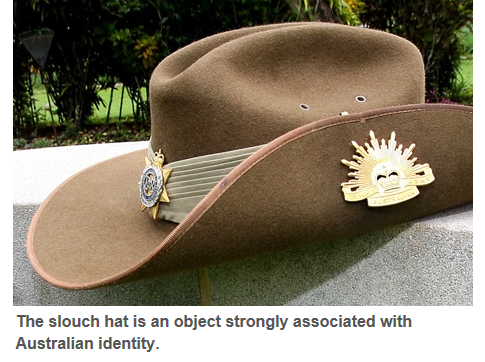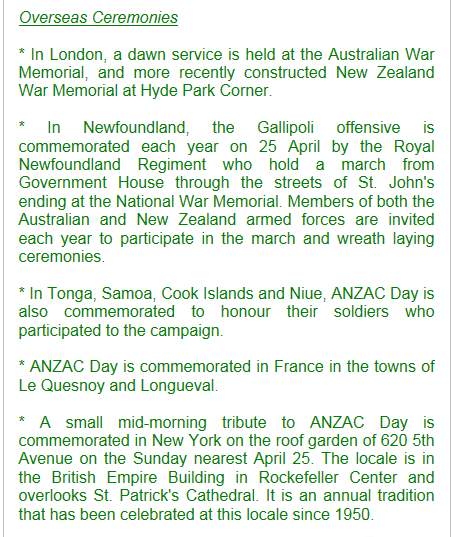ANZAC DAY APRIL 25TH
--------------
----------------
------------------------
ANZAC Day
goes beyond the anniversary
of the landing on Gallipoli in 1915.
It is the day
we remember all Australians
who served and died in all wars,
conflicts, and
peacekeeping operations.
The spirit of ANZAC, with its human qualities of
courage,
mateship, and sacrifice,
continues to have meaning and relevance
for
our sense of national identity.
On ANZAC day, ceremonies are held in towns and
cities
across the nation to acknowledge the service of our veterans.
----------------
ANZAC Day – 25 April – is probably
Australia's most important national occasion.
It marks the anniversary of the
first major military action fought
by Australian and New Zealand forces during
the First World War.
What does ANZAC stand
for?
ANZAC stands for Australian and New Zealand
Army Corps.
The soldiers in those forces quickly became known as ANZACs,
and
the pride they took in that name endures to this day.
When war broke out in 1914,
Australia
had been a federal commonwealth for only 13 years.
The new national government
was eager to establish its reputation
among the nations of the world.
In 1915
Australian and New Zealand soldiers formed part
of the allied expedition that
set out to capture the Gallipoli peninsula
in order to open the Dardanelles to
the allied navies.
The ultimate objective was to capture Constantinople (now
Istanbul in Turkey),
the capital of the Ottoman Empire,
an ally of Germany.
The Australian and New Zealand forces
landed on Gallipoli on 25 April,
meeting fierce resistance from the Ottoman
Turkish defenders.
What had been planned as a bold stroke to knock Turkey
out
of the war quickly became a stalemate,
and the campaign dragged on for eight
months.
At the end of 1915 the allied forces were evacuated,
after both sides
had suffered heavy casualties
and endured great hardships.
Over 8,000
Australian soldiers had been killed.
News of the landing on Gallipoli had made
a profound impact
on Australians at home,
and 25 April soon became the day on
which Australians remembered
the sacrifice of those who had died in the war.
Although the Gallipoli campaign failed
in its military objectives,
the Australian and New Zealand actions during the
campaign
left us all a powerful legacy.
The creation of what became known as
the “ANZAC legend”
became an important part of the identity of both nations,
shaping the ways they viewed both their past and their future.
---------------------
New Zealand
The total number of New Zealand
troops and nurses to serve overseas in 1914-1918,
excluding those in British
and other Dominion forces,
was 103,000, from a population of just over a
million.
Forty-two percent of men of military age served in the NZEF.
16,697
New Zealanders were killed
and 41,317 were wounded during the war
- a 58
percent casualty rate.
Approximately a further thousand men died within five
years of the war's end,
as a result of injuries sustained,
and 507 died whilst
training in New Zealand between 1914 and 1918.
New Zealand had one of the
highest casualty
and death rate per capita of any country involved in the war.
(from Wikipedia)
-------------------
Workers successfully repair a damaged seawall at Gallipoli
Updated Tue Apr 23, 2013 9:47pm AEST
Workers successfully repair a damaged seawall at Gallipoli ahead of
Anzac Day, 2013.
-------------------------
--------------------------
Rememberance song
------------------------------
The Army refers to the slouch hat by its
official designation;
Hat khaki fur felt (KFF) -
to everyone else it is a
‘Slouch Hat’.
The word ‘slouch’ refers to the sloping brim.
The brim is made from rabbit-fur
felt or wool felt
and is always worn with a puggaree.
History has it that the origins of the Slouch Hat began
with the Victorian
Mounted Rifles;
a hat of similar design had been worn in South Africa
by the
Cape Mounted Rifles for many years before 1885.
The design of the Victorian
Mounted Rifle hat
originated from headgear of native police in Burma
where
Lieutenant-Colonel Tom Price had recognised its value.
The Victorian hat was an ordinary bush felt hat
turned up on the right side.
The intention of turning up the right side of the hat
was to ensure it would
not be caught during the drill movement
of “shoulder arms” from “order arms”.
------------------
---------------------------------------
Anzac Day 2013
----------------------

















1 comment:
What a great history lesson for me. Thank you. We all have our heroes and we all need to remember those that gave so much or gave their all.
Have a terrific day Phil. ☺
Post a Comment